Samsung Galaxy S 4 Review - Part 1
by Brian Klug on April 24, 2013 12:01 AM ESTDisplay
We wrote about how we suspected that SGS4 would go to a 5-inch 1080p SAMOLED display just after CES. Turns out that was spot on, as the SGS4 includes a 5-inch 1080p Full HD SAMOLED panel, the latest in Samsung's AMOLED roadmap. Samsung's naming stays true, and there's no Plus tacked on at the end, so we get another non-RGB stripe subpixel geometry with SGS4. The last few Samsung AMOLED variants we've seen have had different subpixel grids, and the one on the SGS4 is possibly the most interesting to date. There's still a bias toward more green subpixels than blue or red, this isn't an RGB stripe at all, but instead of the previous RG,BG layout we see this offset pattern with green on one line, then blue and red on another line. Interestingly enough the blue subpixel appears to be a square, and red and green appear to be circles, with the difference in area possibly offsetting the luminous efficiency of each material. Whatever the reason (Samsung has never been official or forthcoming any of these subpixel patterns each time they've changed them) it's present on the SGS4.
At this size however I have to admit that I find the pursuit of the subpixel geometry more of an educational one than something which affects users. While I could occasionally see it on the SGS3, I definitely do not see it on SGS4. The subpixels are now small enough that whatever the pattern, it all looks like a homogenous light-emitting surface, which was the goal after all. I could bring up the visual acuity discussion again but just trust me that it's small enough to not be visible even with actually perfect (not legally perfect, which is different) vision.
So resolution is great and up to par with all the other LCD-bearing flagships this year, lack of RGB stripe notwithstanding. There's that remaining question about brightness, contrast, outdoor visibility, and of course calibration and the saturation issue that has persisted with AMOLED from generation to generation.
On the brightness front, the SGS4 includes dynamic contrast functions that cannot be disabled and change as a function of what is being displayed. There's an "auto adjust screen tone" checkbox under display but don't let that fool you, that doesn't disable dynamic contrast, just white point. Under screen mode are the mDNIe toggles we've seen on countless other previous Samsung Android phones with AMOLED panels, only here we notice something interesting. There have always been four toggles as long as this option has existed, only what's different is now, one of them is named "Professional photo." Reviews of other regional variants of the SGS4 have included the same button but marked "Adobe RGB." Oddly enough it seems that the North American versions at least have this renamed for some reason, but undoubtedly the function is the same. Many speculated that this is now a toggle for some full CMS (Color Management System) which "fixes" the inherent color space issues with AMOLED and oversaturation that occurs when looking at sRGB content on such devices. Unfortunately, I can confirm that my initial suspicions that this is just a continuation of the mDNIe (lite) settings from previous generation is in fact correct. I reverse engineered what I could of these settings from both kernel messages while changing the toggles, and looking at the kernel sources. Turns out that 'Professional photo' mode is actually the 'Natural' mode renamed from previous versions.
So the question was whether the color space or white point actually does change with this mode enabled. I ran the SGS4 through our display tests in each of the modes and think the full color space plot tells the story. The sanest of them all really ends up being the strangely-named 'Movie' mode. Professional photo gives the big gamut with a white point closer to 'Movie,' which is to say around 7000K, but it doesn't fundamentally change the still-present oversaturation or color management issue that exists in Android with these wide gamut displays. Most users admittedly don't care however and just see "bright" colors. Theres' an Auto mode as well which the device ships with that basically has a matrix of mDNIe settings for targeted applications (for example the Gallery, Browser, Video playback) and so forth get settings, which you can see in the kernel.
| CalMAN Display Comparison | ||||||||||||
| Metric | iPhone 5 | iPhone 4S | HTC One X | SGS3 | Samsung Galaxy Note 2 | Google Nexus 4 | HTC Droid DNA | HTC One | SGS4 | |||
| Grayscale 200nits Avg dE2000 | 3.564 | 6.162 | 6.609 | 4.578 | 5.867 | 7.686 | 6.738 | 5.391 | 7.511 | |||
| CCT Avg (K) | 6925 | 7171 | 5944 | 6809 | 7109 | 8506 | 8108 | 8118 | 7020 | |||
| Saturation Sweep Avg dE2000 | 3.591 | 8.787 | 5.066 | 5.460 | 7.986 | 8.517 | 5.856 | 3.365 | 7.823 | |||
| GMB ColorChecker Avg dE2000 | 4.747 | 6.328 | 6.963 | 7.322 | 8.185 | 7.531 | 6.687 | 4.656 | 7.440 | |||
In the "Movie" mode things are better controlled than the Note 2 on the GMB color checker card test, which is the most important one for me. White point is also no longer the crazy 8000K that we saw before, 7000K is commendable for Samsung at this point. Keep in mind that maximum brightness changes in each mode as well as we effectively clamp things, I measured a maximum of 319 nits in Dynamic mode, 311 nits in Movie mode, and 255 nits in Standard, for example.
Running the display at maximum brightness for too long will also get you into an overheating or thermal protection mode as well, which we've seen on countless other AMOLED variants. Most of the time I suspect users will run on Auto brightness however which keeps brightness down to a much lower level to save battery and prevent that from becoming a problem.
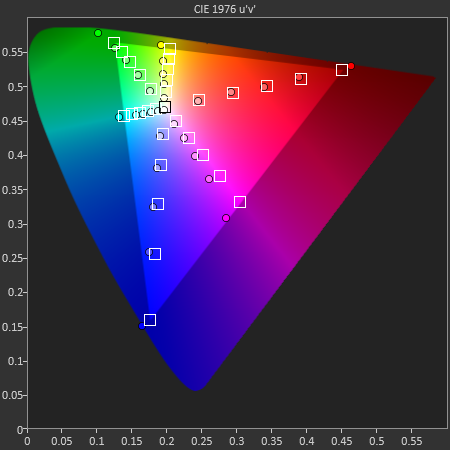
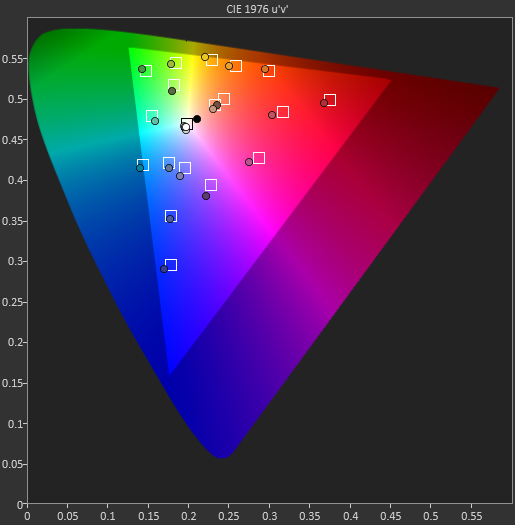
Because "Movie" was the closest to sRGB of all the modes, I selected it for the actual results that I'll present in the table. Admittedly this mode does tighten things up a bit, but it still isn't perfect and I'd still like to see Samsung do something to reign this in at some point.


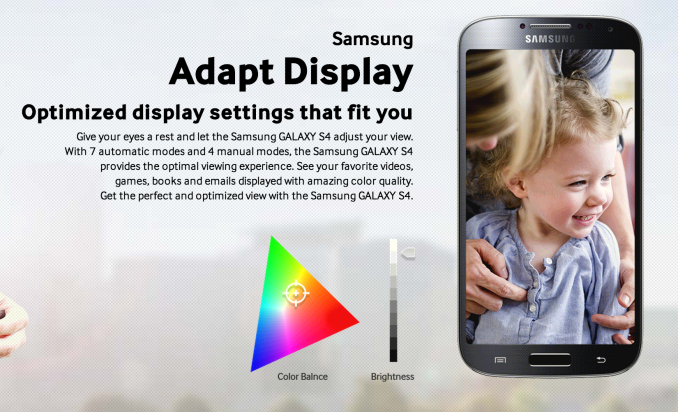




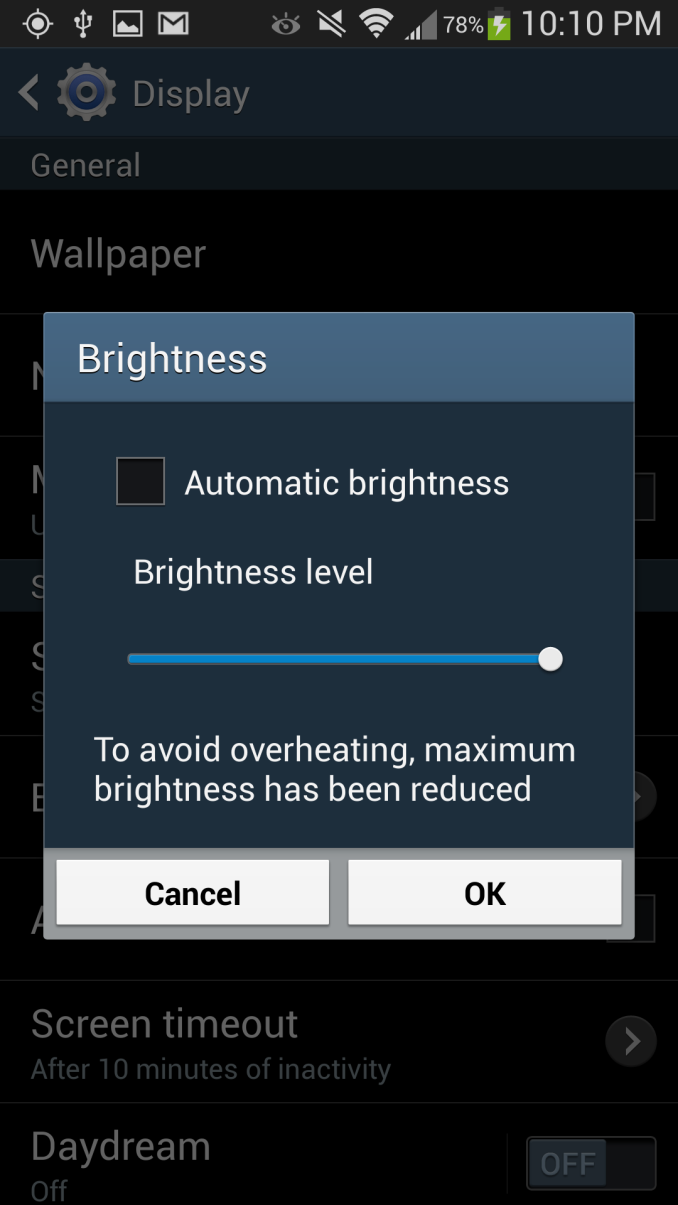
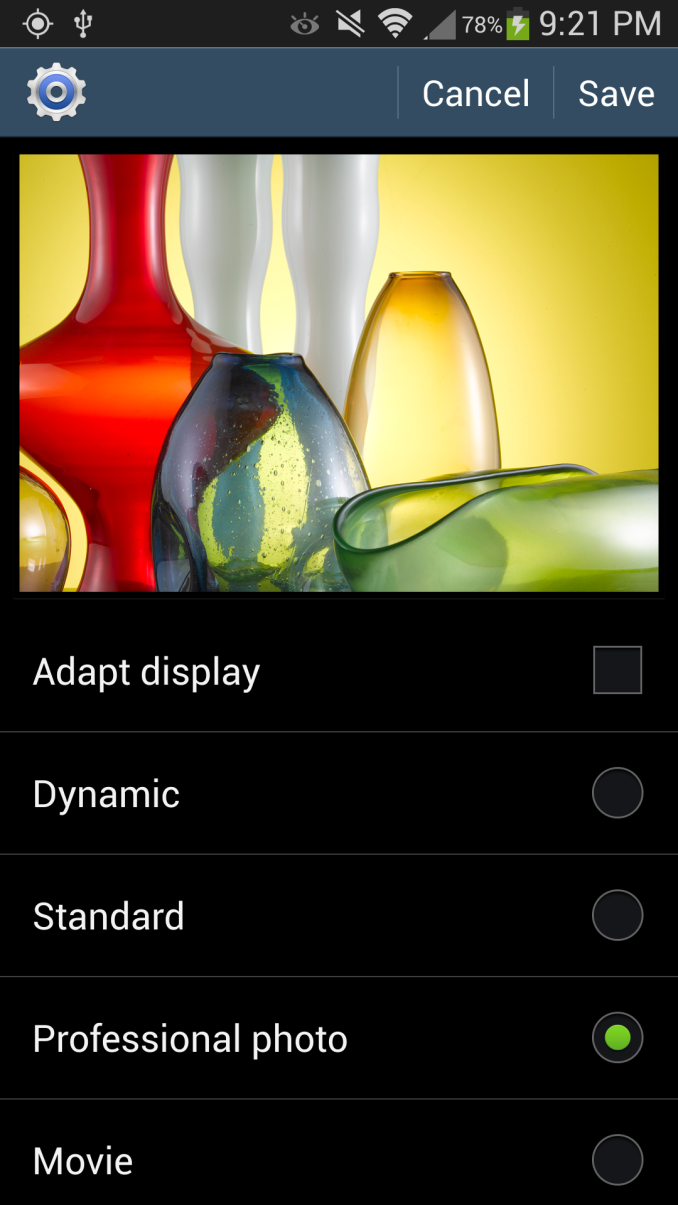
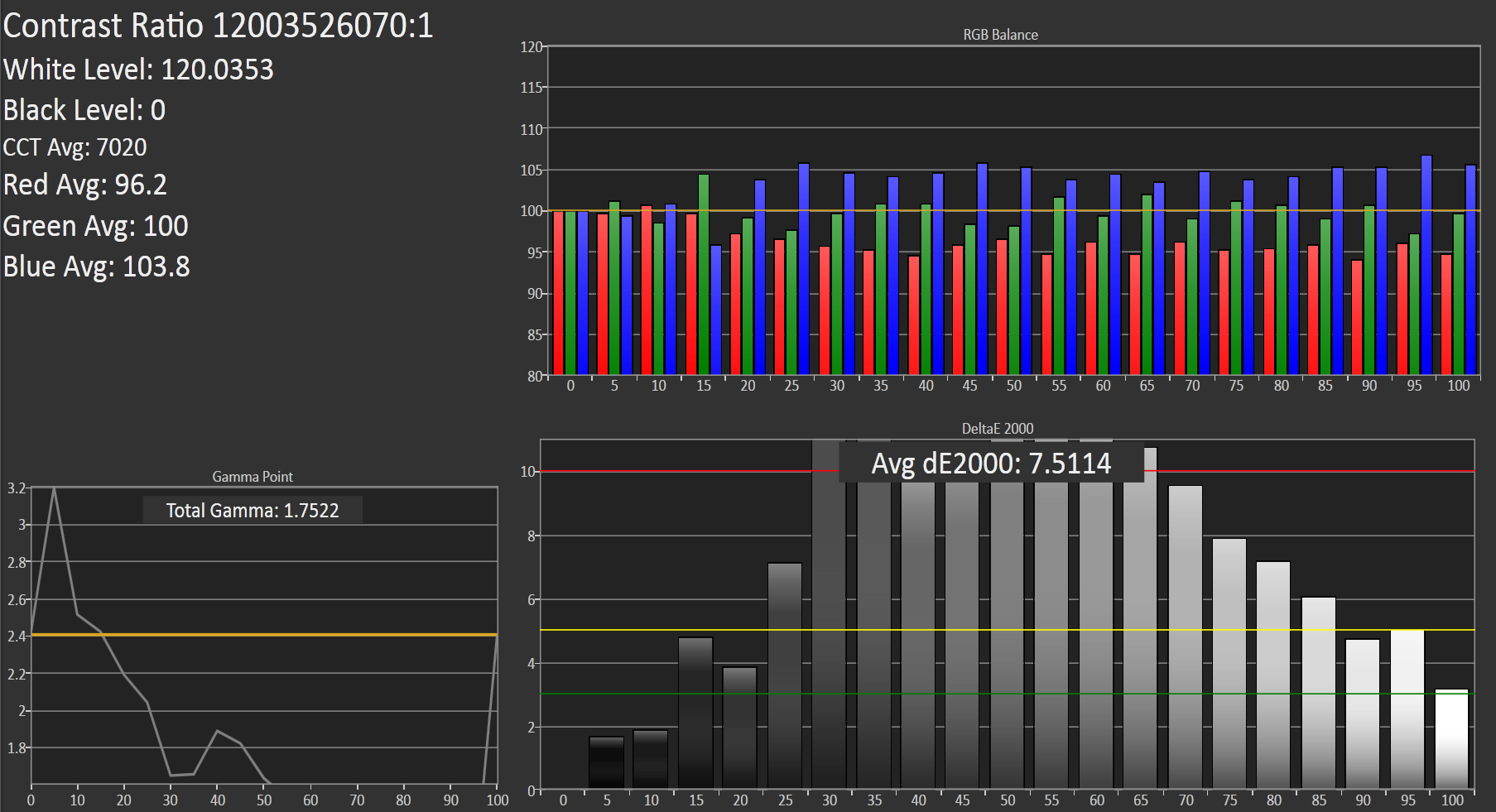








335 Comments
View All Comments
Roffles12 - Wednesday, April 24, 2013 - link
fans of the solid aluminum chasis are a very vocal and illogical minority. very annoying in fact. i have yet to hear any logical argument for why it's better. "it feels nicer in the hand" isn't a reason, but rather a completely subjective opinion. by my logical observation, the aluminum phones are actually more fragile and prone to scratching. aluminum is also more rigid which means it will have greater energy transfer on shock impact, resulting in a greater chance of shock energy transferring to the screen, thus damaging it. you're almost forced to purchase a case to protect it.i think the sales figures for the gs3 alone show that most people don't care if their phone looks like a piece of jewelery. please save your opinions of vanity for the imaginary fashion show in your head. i much prefer polycarbonate plastics for logical reasons. i've been using my gs3 for a year without a case and it looks just like new. if i want to be flashy, i'll wear my nicest watch. my phone is for functionality, so the gs3's build is par for the course. The 45 total second battery swap of a GS3/4 (thanks for flexible plastics) compared to 3.7 hour charging for the HTC One (thanks to a solid metal frame) is all that really needs to be said on the matter. case closed. argument over. shup up. go away.
Crono - Wednesday, April 24, 2013 - link
I like how you dismiss a view as being "a completely subjective opinion", then proceed to give your opinion, " i much prefer polycarbonate plastics", and conclude with a rather immature and unconvincing, "shup up. go away."Truth is some people prefer a solid aluminum body for the same reason one might prefer a more aesthetically premium vehicle. A phone is a tool, but when you are talking about high-end specs - and the GS4 is only marginally better CPU-wise in real-world, observable performance, about equal in other areas, and lower in some - a better quality chassis might make the difference.
I don't care if someone prefers the GS4 for whatever reason, but stop pretending (and apparently you are by virtually putting your fingers in your ears with that last comment) that Samsung doesn't make cheaper casing and without offering a lower price for the end consumer.
It's not even the fact that it's plastic or polycarbonate or whatever you want to call it, as Nokia and HTC make quality plastic bodies. There isn't a good excuse for cheap looking and feeling bodies, even if it's semi-durable without a third party case. This isn't the equivalent of an econobox in the car world, the Galaxy commands a high price.
If you really are satisfied with the Galaxy line, then feel free to complain when Samsung finally gets the message and decides to make truly premium-bodied phones: because they eventually will have to if HTC succeeds with the One.
Roffles12 - Wednesday, April 24, 2013 - link
There is nothing subjective about the fact that polycarbonate plastics and a better material choice for a hand held daily use device than aluminum because of its durability, elasticity, ability to absorb shock and ability to shape into different sizes and thickness while still maintaining those superior properties. I was obviously commentating on the weaknesses of aluminum in CONTRAST to polycarbonate materials. If you can't read between the lines of my comment and apply some common sense, then you need to go back to school. I'm done with you... go back to the verge where you can all have a circle jerk with your fragile tech jewelery.RealityMonster - Monday, April 29, 2013 - link
Actually, that's entirely subjective. The energy transfer argument is really only meaningful when you're talking about a device with moving parts or parts that are likely to break off because of the shock. The plastic back isn't really going to help the screen very much (that is, if the phone falls on its back, the screen isn't going to break, and if it falls on its front, the back isn't going to help), and there are very few parts inside the phone that are likely to move much at all given the impact. In fact, I see people with phones that have busted glass all the time, and the phone itself is still working. (I've seen both an SGS3 and an iPhone 4 working this way.)Plastic is more likely to shatter on impact (which is to say plastic shatters and aluminum won't), and if the plastic back falls and cracks, it probably won't snap back on anymore. On the MOHS hardness scale, aluminum is definitely higher than plastic, which means there are fewer things that can scratch it.
Maybe you don't think it's important what the body material is, but I don't think your bias against aluminum is particularly justified. Aluminum is going to have structural rigidity that the polycarbonate doesn't have, which is why you can use it structurally on the outside of the phone.
I'd actually like to know what the relative carbon footprint of the two materials is. On the one hand, aluminum has to be mined and machined, but plastic all comes from oil and I don't know if it's recyclable in this form. That's the sort of thing that I think is important.
Thegonagle - Wednesday, April 24, 2013 - link
Jeez, that's kind of like saying "it's annoying that people buy Cadillacs when Chevys do the same thing." It's a matter of style and differing taste.Kutark - Thursday, April 25, 2013 - link
Isn't rampant fanboism grand ;-).blau808 - Wednesday, April 24, 2013 - link
Giving up MicroSD and removable battery just for aluminium? Pffft.dyc4ha - Wednesday, April 24, 2013 - link
Why is it so hard for you people to understand that not everyone (I am comfortable in saying the majority) uses up ALL 32GB on their phone. Removable battery/External battery pack, both involves carrying an extra piece. I dont see the big difference here. Actually with the battery pack I can have undisrupted continuous use whereas removable battery requires that I switch off the phone and then replace the battery.jeffkibuule - Thursday, April 25, 2013 - link
Not only that, in order to charge the battery, it has to be in the phone. POINTLESS.ojchurch - Friday, April 26, 2013 - link
Have you never heard of external battery chargers?With an extra battery I can use my phone for 7/8 hours at work for updating spreadsheets, pdfs etc. on a building site with limited access to power and still have a spare battery for use in the evening. Or have a more "normal" usage pattern and not charge the phone for a couple of days. You have more freedom in how you can use your phone.